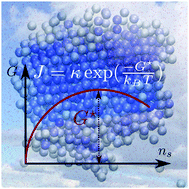Theoretical prediction of the homogeneous ice nucleation rate: disentangling thermodynamics and kinetics†
Abstract
Estimating the homogeneous ice nucleation rate from undercooled liquid water is crucial for understanding many important physical phenomena and technological applications, and challenging for both experiments and theory. From a theoretical point of view, difficulties arise due to the long time scales required, as well as the numerous nucleation pathways involved to form ice nuclei with different stacking disorders. We computed the homogeneous ice nucleation rate at a physically relevant undercooling for a single-site water model, taking into account the diffuse nature of ice–water interfaces, stacking disorders in ice nuclei, and the addition rate of particles to the critical nucleus. We disentangled and investigated the relative importance of all the terms, including interfacial free energy, entropic contributions and the kinetic prefactor, that contribute to the overall nucleation rate. Breaking down the problem into pieces not only provides physical insights into ice nucleation, but also sheds light on the long-standing discrepancy between different theoretical predictions, as well as between theoretical and experimental determinations of the nucleation rate. Moreover, we pinpoint the main shortcomings and suggest strategies to systematically improve the existing simulation methods.



 Please wait while we load your content...
Please wait while we load your content...